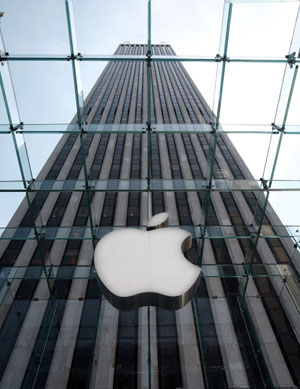Apple technology brings World Cup updates to millions
(MacCentral)
Updated: 2006-06-23 13:56 Chances are if you're watching
highlights from the FIFA World Cup matches on television, you are seeing Apple
technology hard at work. Highlights from the world's most popular sport are
being prepared using multiple Apple products and technologies.

The Apple logo hangs
from the entrance new Apple retail store on Fifth Avenue, with the GM
building in the background in New
York.[filephoto] |
The biggest of the television networks using Apple products is the Host
Broadcast Service (HBS), which is a collection of production groups brought
together specifically for the 2006 World Cup.
From its master control center to the dozens of cameras at each match, the
production team is responsible for everything from managing the feeds coming
back to the Munich headquarters to quickly delivering highlights to mobile
phones within minutes of the action happening on the field.
The HBS delivers its highlight clips to 50 networks around the world as the
games are happening. To accomplish this the group is using four Power Mac G5s,
PictureReady software and AJA Kona cards to DVCPRO HD 1080i50. The feeds from
the games are recorded into a 20TB Apple Xsan.
A total of three Final Cut Pro systems monitor the games currently being
played and recorded -- if the production team sees something highlight worthy, a
15 second clip is immediately edited and exported through QuickTime. These clips
are then made available to its network subscribers.
The Japanese television station NHK is also using Apple technology to produce
its HD World Cup coverage.
Using the same setup it used to broadcast the Torino Olympics, NHK is using
five Power Mac G5s and PictureReady. The five feeds are recorded at at DVCProHD
1080i50 directly to a 36TB Xsan system.
One Power Mac is being used with Final Cut Pro to create broadcast pieces and
a second machine packages the content ready for broadcast.
Finally, the second largest Mexican broadcaster, TV Azteca has adopted a
slightly different approach using five MacBook Pros with Matrox MXOs and HDV
footage to deliver packages from venues around Germany.
Editors for TV Azteca shoot on location, edit the content in Final Cut Pro
and then connect the Matrox MXO to an SDI or HDSDI satellite link that will send
their final edit from the field to the TV Azteca operations center.
The final step is when the operators output their HD sequence to their local
VTR for archival and future HD broadcasting.
|